Investigating Stakeholder Perceptions of Fish Decline: Making Sense of Multiple Mental Models
Abstract
:1. Introduction
2. Materials and Methods
2.1. Study Site
2.2. Governance Framework
2.3. Participant Selection
2.4. Elicitation of Perception Data
2.4.1. Creating Mental Models
2.4.2. Stakeholder Data
- Sources of knowledge about drivers of fish decline and interventions that mitigate drivers,
- How drivers and interventions affect stakeholders,
- Involvement in the decision-making process,
- Role in conserving fish,
- Communication between stakeholder types,
- Perceived priorities in management.
2.5. Data Analysis
3. Results
3.1. Comparison of Perceptions about Main Drivers within Stakeholder Types
3.2. Comparison of Perceptions about Main Drivers
3.3. Comparison of Perceptions about Conservation Interventions
3.4. Personal Experiences that Shaped Perceptions
3.5. Values, Priorities and Involvement in the Decision Making-Process
3.6. Perceptions about Communication Patterns between Stakeholder Types
3.7. Communication Patterns in Relation to Similarities in Perceptions about Drivers and Interventions
4. Discussion
4.1. Perceptions of Resource Decline among Stakeholder Types
4.2. How Stakeholder Types Formed Their Perceptions and How They Interact
4.3. Why Perceptions Were Different
4.4. Why Perceptions Were Not Shared
4.5. Suggestions to Improve Knowledge and Perception Sharing
5. Conclusions
Acknowledgments
Author Contributions
Conflicts of Interest
Appendix A. Semi-Structured Questions Asked during Discussions
- Sources of knowledge about drivers of fish decline and interventions that mitigate drivers.
- Where did you learn about drivers of fish decline and interventions that mitigate drivers?
- Have you participated in any workshops, trainings, or conferences?
- Have you conducted any workshops, trainings, or conferences?
- What else has shaped your perceptions on drivers of fish decline and interventions that mitigate drivers?
- How drivers and interventions affect stakeholders.
- How have any of the drivers positively affected you?
- How have any of the drivers negatively affected you?
- How have any of the interventions positively affected you?
- How have any of the interventions negatively affected you?
- Involvement in the decision-making process.
- How involved is your group in the decision-making process regarding the implementation of conservation strategies?
- Do you wish to be more or less involved?
- Role in conserving fish.
- What are the aims/roles of your group in protecting fish populations in the Danajon Bank?
- How do you achieve your aims?
- Are fish important to protect?
- What, if any, are the benefits of fish?
- Which is more important: receiving those benefits immediately, or receiving those benefits in the future?
- Communication between stakeholder types.
- How well do you communicate with the other two stakeholder types?
- How well do you understand the actions of the other two stakeholder types?
- In the past, what good interactions have you had with the other two stakeholder types?
- How were those good interactions initiated and how will good interactions be sustained?
- In the past, what bad interactions have you had with the other two stakeholder types?
- How were those interactions initiated?
- Were those interactions resolved and, if yes, how?
- Perceived priorities in management.
- What general improvements to fish management would you like to see?
- How could this be achieved?
- What interventions are not listed on your mental models but would be effective if present?
Appendix B. Description of Each Mental Model Node As Defined by Participants in the Study
- Human population increase: An increase in the number of people.
- Climate change: A change in normal weather patterns.
- Conflicting government policies: Decision-makers having different agendas and methods to conserve marine resources.
- Don’t understand causal effects: Being aware of a given driver but unsure how it relates to fish decline.
- Lack of opportunity: Limited occupational options for people.
- Inability to implement regulations: Regulations to conserve fish populations are not implemented due to conflicting priorities and limited resources among decision-makers.
- Poverty: The state of being poor and being dependent on fish as a source of nutrients.
- Weak leadership approach: Making poor decisions that negatively affect the marine environment.
- Increase in natural disasters: Presence of more destructive and frequent natural disasters such as typhoons and earthquakes.
- Non-compliance: Failing to act in accordance with laws and regulations pertaining to conservation of marine resources.
- Weak enforcement: Failing to enforce laws and regulations pertaining to conservation of marine resources.
- Dynamite fishing: The practice of using explosives to stun and/or kill fish, which also negatively affects underlying and nearby habitats.
- Chemical fishing: Often associated with compressor fishing. The use of cyanide or chlorine to stun and/or kill fish. This also negatively affects underlying and nearby habitats.
- Trawl fishing: Referring to either mid-water or bottom trawling. The use of large nets towed by boats to catch fish, which also negatively affects underlying habitats.
- Pollution: The introduction of harmful substances into the marine environment such as plastic and nutrient runoff from farming.
- Commercial fishing: The practice of catching large quantities of fish for profit, which often occurs illegally within municipal waters.
- Mangrove cutting: The practice of harvesting mangroves for different purposes such as building supplies and kindling for cooking.
- Encroachment: The act of fishing in an area that is designated as protected from fishing.
- Bad farming practices: The act of adding excessive pesticides and fertilizers to plants.
- Coral and sand quarrying: The act of harvesting coral or sand to create cement, to be sold as curios, or to replenish beaches.
- Overfishing: The act of fishing past the point where the remaining fish populations can replenish themselves.
- More fishers: A greater presence of fishers.
- Fish get poisoned: Fish becoming sick from various destructive fishing methods.
- Biodiversity loss: A decrease in the number of species.
- Juvenile decline: A decrease in the number of juvenile fish.
- Fish eat garbage: Fish eating garbage such as plastic.
- Loss of aggregation: Thinning out of large schools of fish.
- Chemical runoff: Chemicals such as pesticides entering the marine environment.
- Turbidity/siltation: The process of substrate and/or corals being covered with matter such as sand or silt
- Habitat destruction: The loss of habitat that is utilized by marine fauna.
- Too lenient: Excessive laxity in implementation or enforcement of laws and regulations pertaining to the conservation of marine resources.
- No patrol: Complete absence of personnel that enforce laws and regulations pertaining to the conservation of marine resources.
- Increased competition for shelter: Fish having to compete to utilize decreasing available habitats.
- Temperature increase: Ocean temperature being warmer than expected.
- Fish move away: Fish leaving areas they used to inhabit.
- Fish egg decrease: Less egg production than expected.
- Not sure: Do not understand how the node above this one effects the node below, but sure of the connection.
- Loss of viable stock: A decline in the total number of fish needed to maintain future populations.
- Loss of spawners: A decline in the total number of fish that generate new offspring.
- Illegal fishing in municipal waters: Types of fishing such as commercial fishing, which are not allowed within a given distance from shore; also, dynamite and chemical fishing, which are not allowed anywhere.
References
- Pressey, R.L.; Cabeza, M.; Watts, M.E.; Cowling, R.M.; Wilson, K.A. Conservation planning in a changing world. Trends Ecol. Evol. 2007, 22, 583–592. [Google Scholar] [CrossRef] [PubMed]
- Gill, D.A.; Mascia, M.B.; Ahmadia, G.N.; Glew, L.; Lester, S.E.; Barnes, M.; Craigie, I.; Darling, E.S.; Free, C.M.; Geldmann, J.; et al. Capacity shortfalls hinder the performance of marine protected areas globally. Nature 2017, 543, 665–669. [Google Scholar] [CrossRef] [PubMed]
- Pressey, R.L.; Visconti, P.; Ferraro, P.J.; Pressey, R.L. Making parks make a difference: Poor alignment of policy, planning and management with protected-area impact, and ways forward. Philos. Trans. R. Soc. 2015. [Google Scholar] [CrossRef] [PubMed]
- Brown, V.A. A collective social learning pattern. In Proceedings of the CEUR Workshop, Irsee, Germany, 9–13 July 2008. [Google Scholar]
- Bennett, N.J. Using perceptions as evidence to improve conservation and environmental management. Conserv. Biol. 2016, 30, 582–592. [Google Scholar] [CrossRef] [PubMed]
- Hicks, C.C.; Graham, N.A.J.; Cinner, J.E. Synergies and tradeoffs in how managers, scientists, and fishers value coral reef ecosystem services. Glob. Environ. Chang. 2013, 23, 1444–1453. [Google Scholar] [CrossRef]
- Hovardas, T.; Poirazidis, K. Environmental policy beliefs of stakeholders in protected area management. Environ. Manag. 2007, 39, 515–525. [Google Scholar] [CrossRef] [PubMed]
- Folke, C.; Hahn, T.; Olsson, P.; Norberg, J. Adaptive governance of social-ecological systems. Annu. Rev. Environ. Resour. 2005, 30, 441–473. [Google Scholar] [CrossRef]
- De Silva, M.J.; Breuer, E.; Lee, L.; Asher, L.; Chowdhary, N.; Lund, C.; Patel, V. Theory of Change: A theory-driven approach to enhance the Medical Research Councils’ framework for complex interventions. Trials 2014, 15, 267. [Google Scholar] [CrossRef] [PubMed] [Green Version]
- Raymond, C.M.; Fazey, I.; Reed, M.S.; Stringer, L.C.; Robinson, G.M.; Evely, A.C. Integrating local and scientific knowledge for environmental management. J. Environ Manag. 2010, 91, 1766–1777. [Google Scholar] [CrossRef] [PubMed]
- Pomeroy, R.; Douvere, F. The engagement of stakeholders in the marine spatial planning process. Mar. Policy 2008, 32, 816–822. [Google Scholar] [CrossRef]
- Keppel, G.; Alifereti, N.; Issac, R.; Pressey, R.L.; Thomas, N.T. Local and expert knowledge improve conservation assessment of rare and iconic Fijian tree species. Pac. Conserv. Biol. 2015. [Google Scholar] [CrossRef]
- Huntington, H.P. Using Traditional Ecological Knowledge in Science: Methods and Applications. Ecol. Appl. 2000, 10, 1270–1274. [Google Scholar] [CrossRef]
- Bodin, Ö.; Crona, B.I. The role of social networks in natural resource governance: What relational patterns make a difference? Glob. Environ Chang. 2009, 19, 366–374. [Google Scholar] [CrossRef]
- Mills, M.; Álvarez-Romero, J.G.; Vance-Borland, K.; Cohen, P.; Pressey, R.L.; Guerrero, A.M.; Ernstson, H. Linking regional planning and local action: Towards using social network analysis in systematic conservation planning. Biol. Conserv. 2014, 169, 6–13. [Google Scholar] [CrossRef]
- Armitage, D.R.; Plummer, R.; Berkes, F.; Arthur, R.I.; Charles, A.T.; Davidson-Hunt, I.J.; Diduck, A.P.; Doubleday, N.C.; Johnson, D.S.; Marschke, M.; et al. Adaptive co-management for social-ecological complexity. Front. Ecol. Environ. 2009, 7, 95–102. [Google Scholar] [CrossRef]
- Brewer, T.D. Dominant discourses, among fishers and middlemen, of the factors affecting coral reef fish distributions in Solomon Islands. Mar. Policy 2013, 37, 245–253. [Google Scholar] [CrossRef]
- Oldekop, J.A.; Holmes, G.; Harris, W.E.; Evans, K.L. A global assessment of the social and conservation outcomes of protected areas. Conserv. Biol. 2016, 30, 133–141. [Google Scholar] [CrossRef] [PubMed]
- Jones, P.J.S.; Qiu, W.; De Santo, E. Governing Marine Protected Areas: Getting the Balance Right. 2011. Available online: http://www.mpag.info/governing-mpas-final-technical-report-web-res.pdf (accessed on 1 April 2018).
- Lebel, L.; Anderies, J.M.; Campbell, B.; Folke, C.; Hatfield-Dodds, S.; Hughes, T.P.; Wilson, J. Governance and the capacity to manage resilience in regional social-ecological systems. Ecol. Soc. 2006, 11. [Google Scholar] [CrossRef]
- Bennett, N.J.; Dearden, P. Why local people do not support conservation: Community perceptions of marine protected area livelihood impacts, governance and management in Thailand. Mar. Policy 2014, 44, 107–116. [Google Scholar] [CrossRef]
- Ezebilo, E.E.; Mattsson, L. Socio-economic benefits of protected areas as perceived by local people around Cross River National Park, Nigeria. For. Policy Econ. 2010, 12, 189–193. [Google Scholar] [CrossRef]
- Plummer, R. The adaptive co-management process: An initial synthesis of representative models and influential variables. Ecol. Soc. 2009, 14. [Google Scholar] [CrossRef]
- Biggs, D.; Abel, N.; Knight, A.T.; Leitch, A.; Langston, A.; Ban, N.C. The implementation crisis in conservation planning: Could “mental models” help? Conserv. Lett. 2011, 4, 169–183. [Google Scholar] [CrossRef]
- Webler, T.; Danielson, S.; Tuler, S. Using Q Method to Reveal Social Perspectives in Environmental Research. Soc. Environ. Res. 2009, 1301, 1–54. [Google Scholar]
- Karnad, D.; Gangal, M.; Karanth, K.K. Perceptions matter: How fishermen’s perceptions affect trends of sustainability in Indian fisheries. Oryx 2014, 48, 218–227. [Google Scholar] [CrossRef]
- Gurney, G.G.; Cinner, J.; Ban, N.C.; Pressey, R.L.; Pollnac, R.; Campbell, S.J.; Tasidjawa, S.; Setiawan, F. Poverty and protected areas: An evaluation of marine integrated conservation and development project in Indonesia. Glob. Environ. Chang. 2014, 48, 218–227. [Google Scholar] [CrossRef]
- Jones, N.A.; Ross, H.; Lynam, T.; Perez, P.; Leitch, A. Mental Models: An interdisciplinary synthesis of theory and methods. Ecol. Soc. 2011, 16, 46. [Google Scholar] [CrossRef]
- Niemeijer, D.; De Groot, R.S. Framing environmental indicators: Moving from causal chains to causal networks. Environ. Dev. Sustain. 2008, 10, 89–106. [Google Scholar] [CrossRef]
- Armada, N.; White, A.T.; Christie, P. Managing Fisheries Resources in Danajon Bank, Bohol, Philippines: An Ecosystem-Based Approach. Coast Manag. 2009, 37, 308–330. [Google Scholar] [CrossRef]
- CCEF. A Profile of Danajon Bank Philippines. A Portfolio of the Coastal Resource/Socio-Economic Status and Coastal Resource Management Programs in Danajon Bank; Coastal Conservation and Education Foundation: Cebu City, Philippines, 2013. [Google Scholar]
- Sanders, J.S.; Greboval, D.; Hjort, A. Marine Protected Areas: Country Case Studies on Policy Governance and Institutional Issues: Japan, Mauritania, Philippines, Samoa; FAO Fisheries and Aquaculture Technical Paper No. 556/2; FAO: Rome, Italy, 2013; Available online: http://www.fao.org/3/a-i3212e.pdf (accessed on 1 April 2018).
- Christie, P.; Armada, N.; White, A.T.; Gulayan, A.; De Dios, H. Coastal Environmental and Fisheries Profile, Danajon Bank, Bohol, Philippines; Fisheries improved for Sustainable Harvest (FISH) Project: Cebu City, Philippines, 2006; pp. 1–63. Available online: http://oneocean.org/download/db_files/danajon_bank_profile.pdf (accessed on 1 April 2018).
- Mercado, E.S. A Case Study of Ubay, Bohol on Sustainable Coastal and Fishery Resource Management: A Contribution to the Philippines Country Environmental Analysis. 2008, pp. 1–18. Available online: http://siteresources.worldbank.org/INTPHILIPPINES/Resources/WBCEAUbayCaseStudyFINAL.pdf (accessed on 1 April 2018).
- Republic Act No. 7160. Local Government Code of 1991. Republic of the Philippines, 1991. Available online: http://www.lawphil.net/statutes/repacts/ra1991/ra_7160_1991.html (accessed on 1 April 2018).
- Operative Principles of Decentralization. Republic Act No. 7160. Local Government Code of 1991; Republic of the Philippines, 1991. Available online: http://www.lawphil.net/statutes/repacts/ra1991/ra_7160_1991.html (accessed on 1 April 2018).
- Magallona, M.M.; Malayang, B.S. Environmental Governance in the Philippines; Environmental Governance in Southeast Asia, Institute of Global Environmental Strategies: Tokyo, Japan, 2001; Available online: http://site.iugaza.edu.ps/tissa/files/2010/02/Environmental_Governance_in_the_Philippines.pdf (accessed on 1 April 2018).
- Pomeroy, R.S.; Pido, M.D. Initiatives towards fisheries co-management in the Philippines: The case of San Miguel Bay. Mar. Policy 1995, 19, 213–226. [Google Scholar] [CrossRef]
- Republic Act No. 8550. The Philippine Fisheries Code of 1998. Republic of the Philippines, 1998. Available online: http://www.lawphil.net/statutes/repacts/ra1998/ra_8550_1998.html (accessed on 1 April 2018).
- Qualifications, Powers and Duties. Republic Act No. 7160. Local Government Code of 1991; Republic of the Philippines, 1991. Available online: http://www.lawphil.net/statutes/repacts/ra1991/ra_7160_1991.html (accessed on 1 April 2018).
- The Chief Executive: Powers, Duties, Functions and Compensation. Republic Act No. 7160. Local Government Code of 1991; Republic of the Philippines, 1991. Available online: https://www.lawphil.net/statutes/repacts/ra1991/ra_7160_1991.html (accessed on 1 April 2018).
- Republic Act No. 7160. Local Government Code of 1991. Book 3, Title 5, Chapter 3, Article 3: The Sangguniang Bayan. Republic of the Philippines, 1991. Available online: http://www.lawphil.net/statutes/repacts/ra1991/ra_7160_1991.html (accessed on 1 April 2018).
- Zukowski, S.; Curtis, A.; Watts, R.J. Using fisher local ecological knowledge to improve management: The Murray crayfish in Australia. Fish. Res. 2011, 110, 120–127. [Google Scholar] [CrossRef]
- ECOFISH Public-Private Partnership Strategy. Ecosystems Improved for Sustainable Fisheries (ECOFISH) Project; United States Agency International Development, 2013. Available online: http://pdf.usaid.gov/pdf_docs/PA00K5C9.pdf (accessed on 1 April 2018).
- Balgos, M.C.; Pagdilao, C.R. Provincial and Regional Institutions in the Philippines: An Essential Element in Coastal Resource Management and Marine Conservation. Institutional Frameworks for Community Based Coastal Resources Management and Marine Conservation in the Visayas Region. pp. 1–34. Available online: http://www.crc.uri.edu/download/Philippines_Background_Paper.pdf (accessed on 1 April 2018).
- Langjahr, K.K. Improved enforcement and financial support of marine sanctuaries: Perceived factors in eliminating illegal fishing in the Danajon Bank, Philippines. In Proceedings of the 20th International Conference of the Coastal Society, St. Pete Beach, FL, USA, 17 May 2006; pp. 230–234. [Google Scholar]
- Lowry, G.K.; White, A.T.; Christie, P. Scaling Up to Networks of Marine Protected Areas in the Philippines: Biophysical, Legal, Institutional, and Social Considerations. Coast. Manag. 2009, 37, 274–290. [Google Scholar] [CrossRef]
- Yasue, M.; Kaufman, L.; Vincent, A.C.J. Assessing ecological changes in and around marine reserves using community perceptions and biological surveys. Aquat. Conserv. Mar. Freshw. Ecosyst. 2010, 20, 407–418. [Google Scholar] [CrossRef]
- Folke, C.; Pritchard, L.; Berkes, F.; Colding, J.; Svedin, U. The problem of fit between ecosystems and institions: Ten years later. Ecol. Soc. 2007, 12, 30. [Google Scholar] [CrossRef]
- Horigue, V.; Aliño, P.M.; White, A.T.; Pressey, R.L. Marine protected area networks in the Philippines: Trends and challenges for establishment and governance. Ocean Coast. Manag. 2012, 64, 15–26. [Google Scholar] [CrossRef]
- Golder, B.; Gawler, M. Cross-Cutting Tool Stakeholder Analysis. WWF Standards of Conservation Project and Programme Management. 2005. Available online: www.panda.org/standards/1_4_stakeholder_analysis (accessed on 1 April 2018).
- NHMRC. National Statement on Ethical Conduct in Research Involving Humans. NHMRC Act, 1992 (Cth); 1999. Available online: https://www.nhmrc.gov.au/_files_nhmrc/publications/attachments/e35.pdf (accessed on 1 April 2018).
- Özesmi, U.; Özesmi, S.L. Ecological models based on people’s knowledge: A multi-step fuzzy cognitive mapping approach. Ecol. Model. 2004, 176, 43–64. [Google Scholar] [CrossRef]
- Dray, A.; Perez, P.; Iones, N.; Le Page, C.; D’Aquino, P.; Auatabu, T. The atollgame experience: From knowledge engineering to a computer-assisted role playing game. J. Artif. Soc. Soc. Simula. 2006, 9, 149–158. [Google Scholar]
- Porter, S.; Whitcomb, M.; Weitzer, W. Multiple surveys of students and survey fatigue. New Dir. Inst. Res. 2004, 2004, 63–73. [Google Scholar] [CrossRef]
- Hill, R.; Davies, J.; Bohnet, I.C.; Robinson, C.J.; Maclean, K.; Pert, P.L. Collaboration mobilises institutions with scale-dependent comparative advantage in landscape-scale biodiversity conservation. Environ. Sci. Policy 2015, 51, 267–277. [Google Scholar] [CrossRef]
- Bohensky, E.L.; Kirono, D.G.C.; Butler, J.R.A.; Rochester, W.; Habibi, P.; Handayani, T.; Yanuartati, Y. Climate knowledge cultures: Stakeholder perspectives on change and adaptation in Nusa Tenggara Barat, Indonesia. Clim. Risk Manag. 2016, 12, 17–31. [Google Scholar] [CrossRef]
- Adams, W.M.; Brockington, D.; Dyson, J.; Vira, B. Managing Tragedies: Understanding Conflict over Common Pool Resources. Science 2003, 302, 1915–1916. [Google Scholar] [CrossRef] [PubMed]
- Kroon, F.J.; Robinson, C.J.; Dale, A.P. Integrating knowledge to inform water quality planning in the Tully–Murray basin, Australia. Mar. Freshw. Res. 2009, 60, 1183–1188. [Google Scholar] [CrossRef]
- Lamarque, P.; Tappeiner, U.; Turner, C.; Steinbacher, M.; Bardgett, R.D.; Szukics, U.; Schermer, M.; Lavore, S. Stakeholder perceptions of grassland ecosystem services in relation to knowledge on soil fertility and biodiversity. Reg. Environ. Chang. 2011, 11, 791–804. [Google Scholar] [CrossRef]
- Sutton, S.G.; Tobin, R.C. Recreational fishers’ attitudes towards the 2004 rezoning of the Great Barrier Reef Marine Park. Environ. Conserv. 2009, 36, 245–252. [Google Scholar] [CrossRef]
- Gratani, M.; Butler, J.R.A.; Royee, F.; Valentine, P.; Burrows, D.; Canendo, W.I.; Anderson, A.S. Is validation of indigenous ecological knowledge a disrespectful process? A case study of traditional fishing poisons and invasive fish management from the wet tropics, Australia. Ecol. Soc. 2011, 16, 25. [Google Scholar] [CrossRef]
- Gurney, G.G.; Cinner, J.E.; Sartin, J.; Pressey, R.L.; Ban, N.C.; Marshall, N.A.; Prabuning, D. Participation in devolved commons management: Multiscale socioeconomic factors related to individuals’ participation in community-based management of marine protected areas in Indonesia. Environ. Sci. Policy 2016, 61, 212–220. [Google Scholar] [CrossRef]
- Diedrich, A.; Stoeckl, N.; Gurney, G.G.; Esparon, M.; Pollnac, R. Social capital as a key determinant of perceived benefits of community-based marine protected areas. Conserv. Biol. 2017, 31, 311–321. [Google Scholar] [CrossRef] [PubMed]
- Tyler, T.R. Social justice. In APA Handbook of Personality and Social Psychology: Group Processes; APA Handbooks in Psychology; Mikulincer, M., Shaver, P.R., Dovidio, J.F., Simpson, J.A., Eds.; American Psychological Association: Washington, DC, USA, 2015; Volume 2. [Google Scholar]
- Barnes-Mauthe, M.; Shawn, A.; Stewart, A.; PingSun, L. A Network Analysis of Fisher’s Social Capital and the Effects of Ethnic Diversity in Hawaii’s Longline Fishery; SOEST Publication 12-03, JIMAR Contribution 12-381; Pelagic Fisheries Research Program: Honolulu, Hawaii, 2012; Available online: http://www.soest.hawaii.edu/PFRP/soest_jimar_rpts/barnes_arita_leung_ethnic_longline.pdf (accessed on 1 April 2018).
- Berdej, S.M.; Armitage, D.R. Bridging organizations drive effective governance outcomes for conservation of Indonesia’s marine systems. PLoS ONE 2016, 11. [Google Scholar] [CrossRef] [PubMed]
- Johnson, A.; Wouters, M. Strengthening community capacity to undertake conservation work: Sharing conservation skills and knowledge. Sci. Conserv. 2008, 287, 1–74. [Google Scholar]
- Gebresenbet, F.; Bauer, H.; Hunter, L.; Gebretensae, K. Lion conservation workshop in Ethiopia. Cat News 2010, 52, 30. Available online: http://www.rocal-lion.org/documents/Lion_Ethiopia_Proceedings_web.pdf (accessed on 1 April 2018).
- Githiru, M.; Lens, L. Application of fragmentation research to conservation planning for multiple stakeholders: An example from the Taita Hills, southeast Kenya. Biol. Conserv. 2007, 134, 271–278. [Google Scholar] [CrossRef]
- Alem, L.; Kravis, S.; McLean, A. Knowledge Sharing Technologies to Support Community Participation in Natural Resource Management: A Research Agenda. In Proceedings of the Australian Conference on Knowledge Management and Intelligent decision Support, Melbourne, Australia, 11–12 December 2003; pp. 30–41. [Google Scholar]
- Ostrom, E. A behavioral approach to the rational choice theory of collective action. Am. Polit. Sci. Rev. 1998, 92, 1–22. [Google Scholar] [CrossRef]
- Nooy, W. Communication in natural resource management: Agreement between and disagreement within stakeholder groups. Ecol. Soc. 2013, 18. [Google Scholar] [CrossRef]



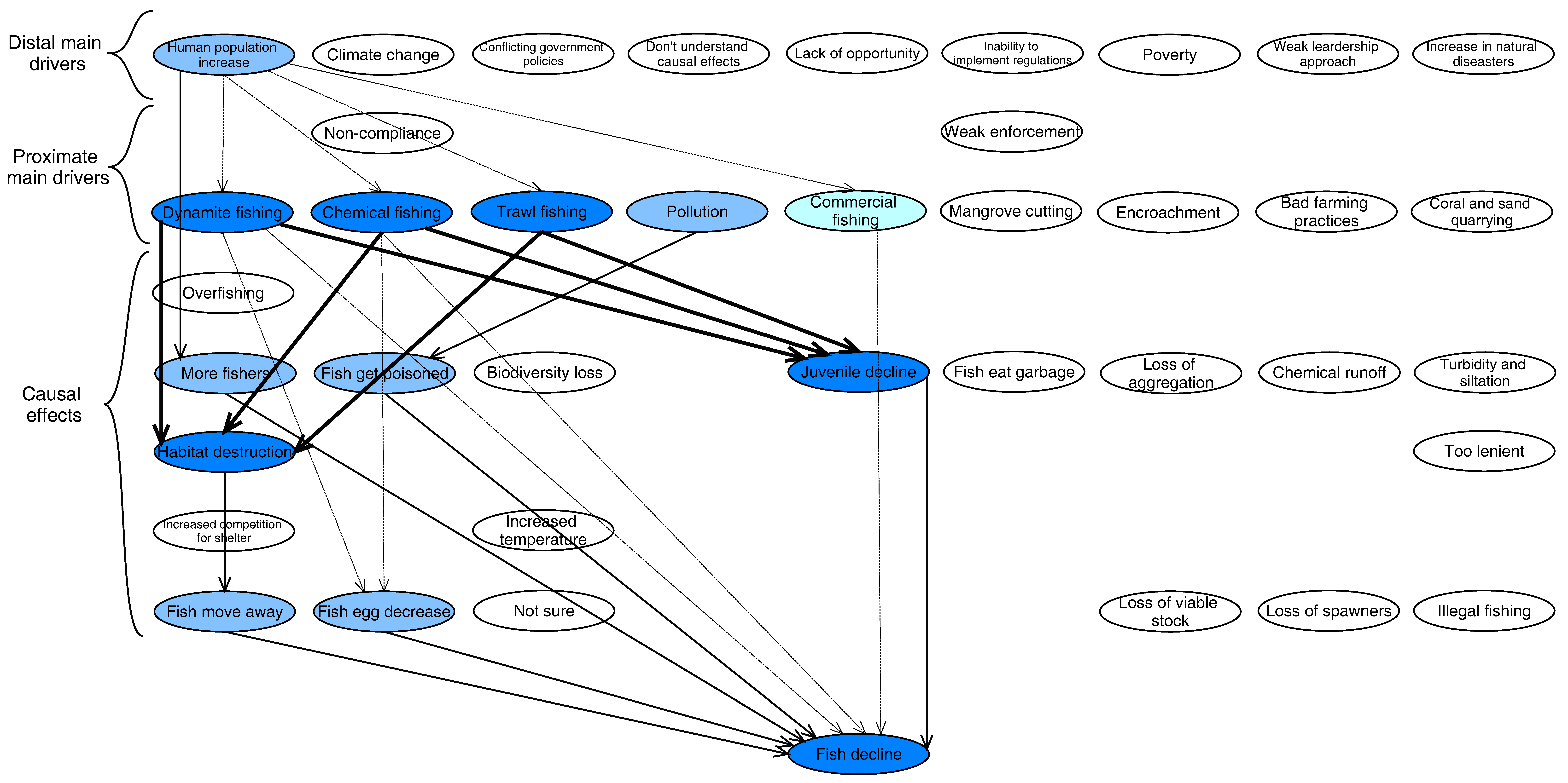
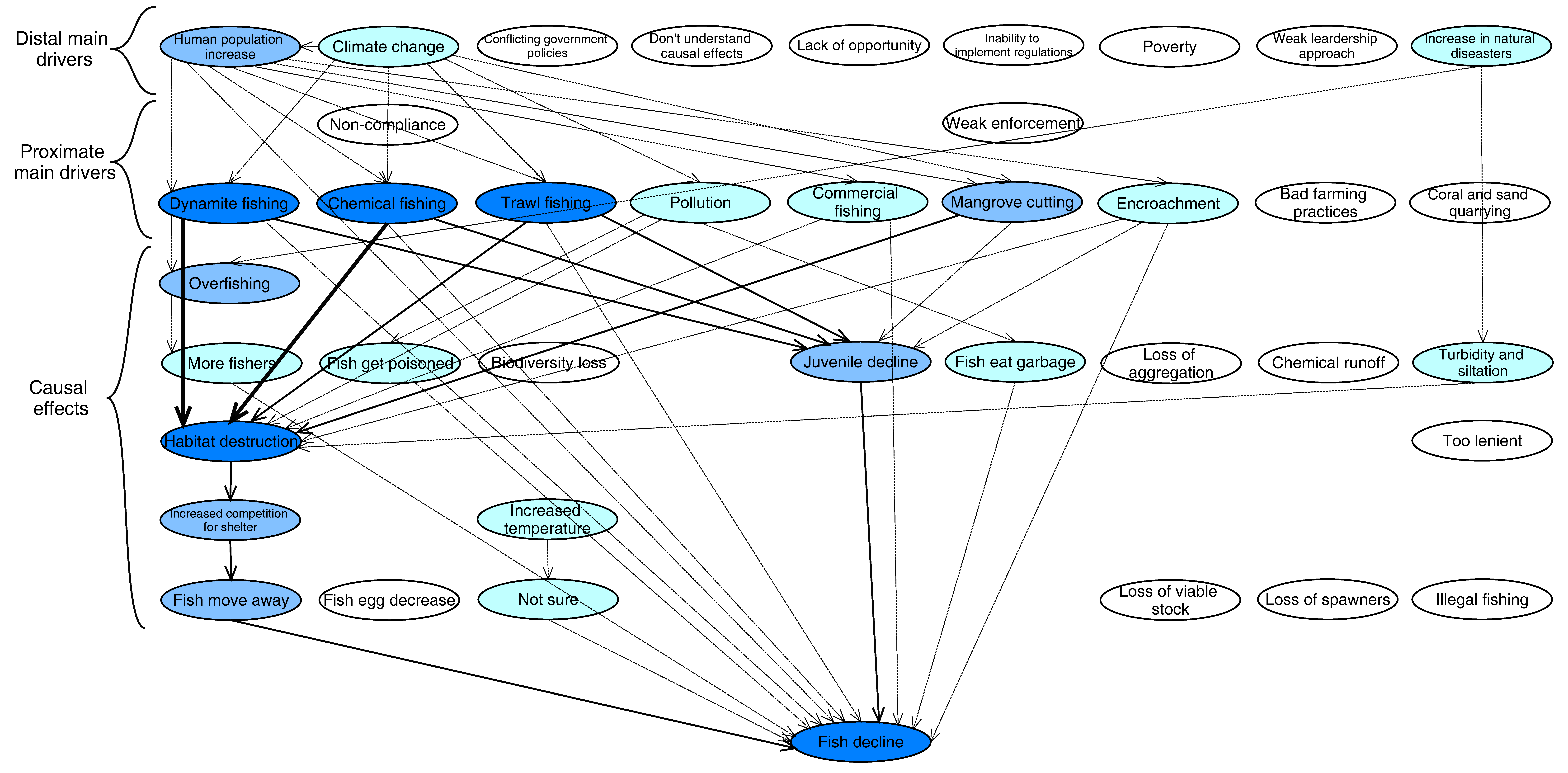
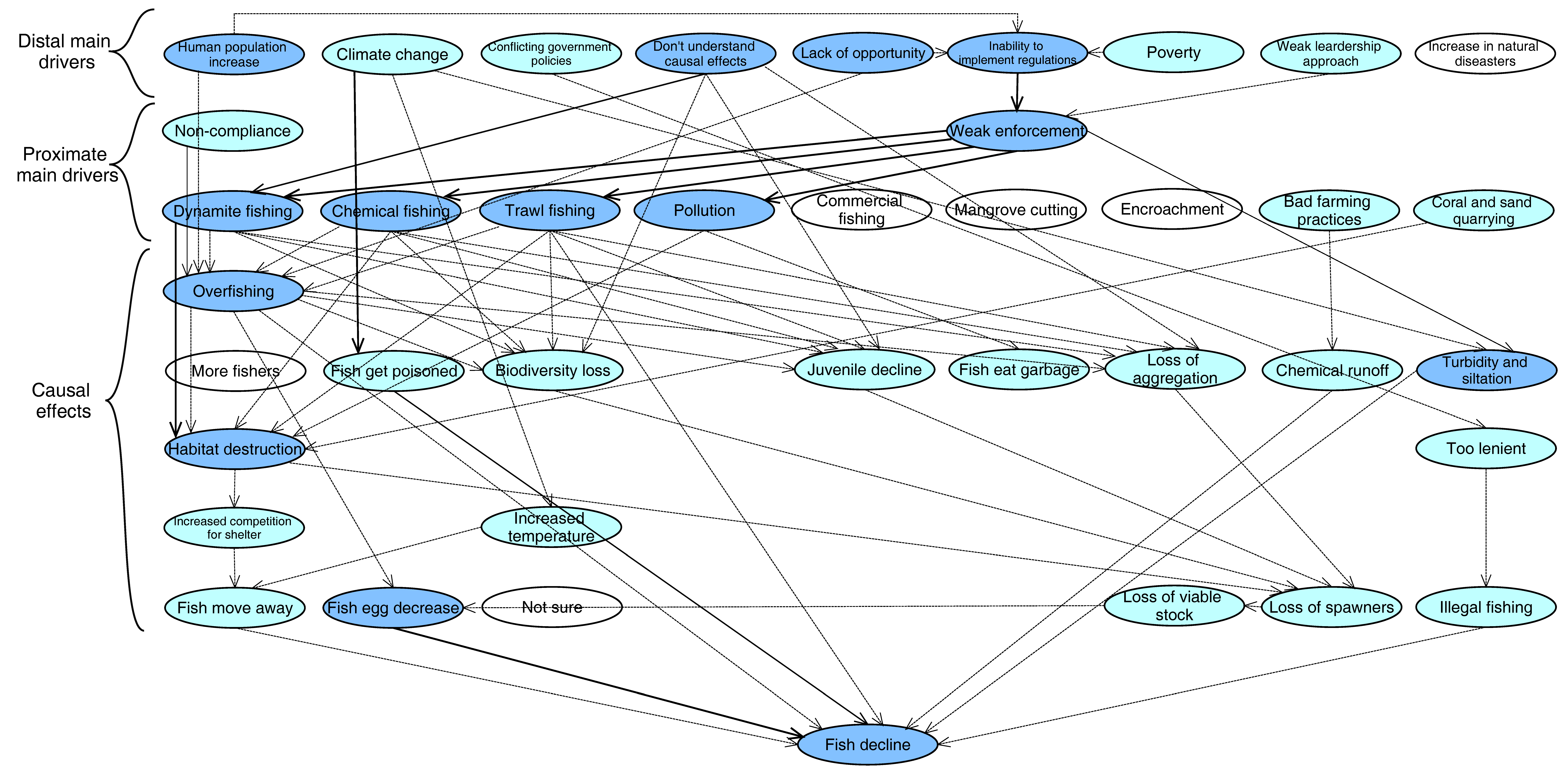
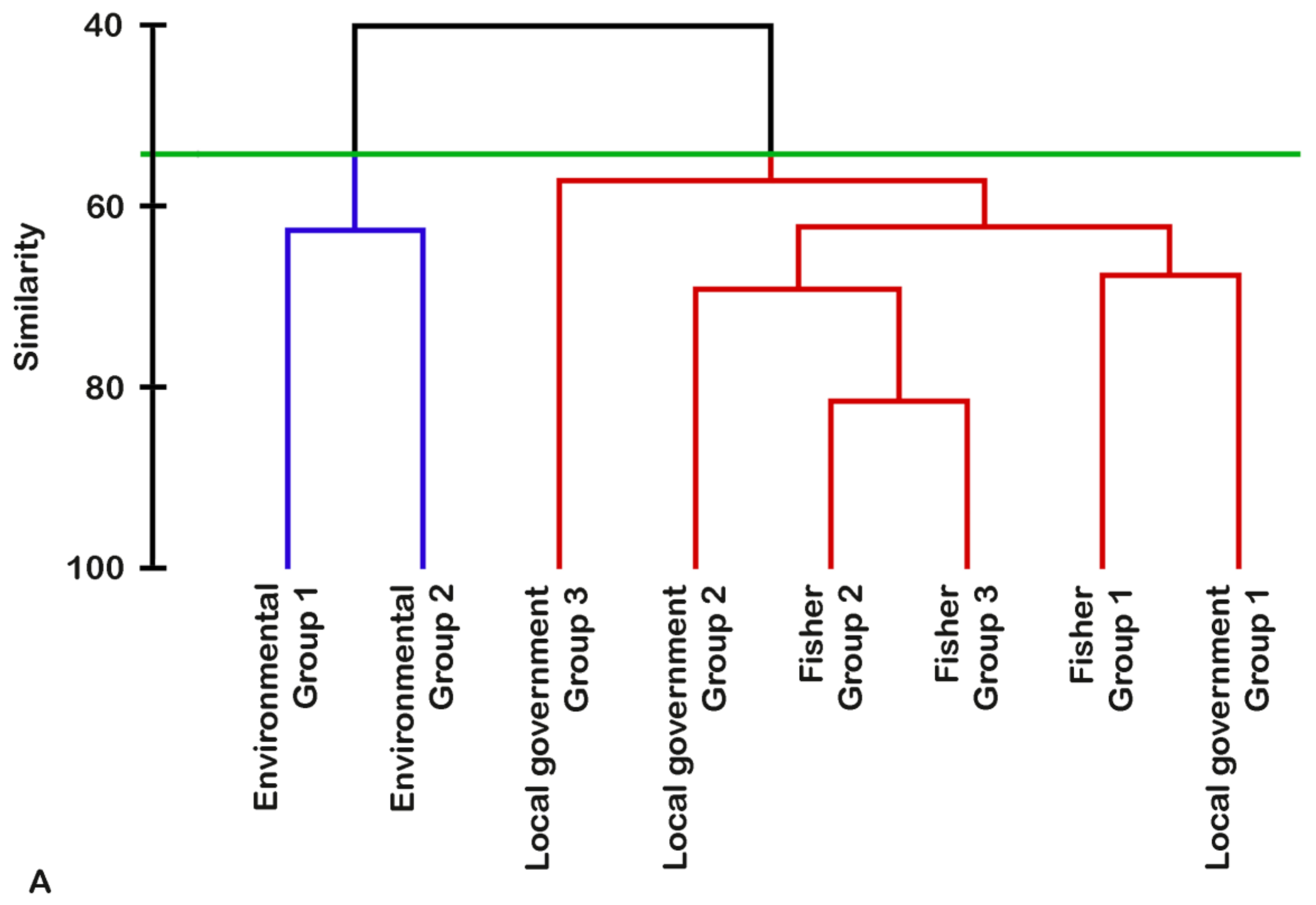
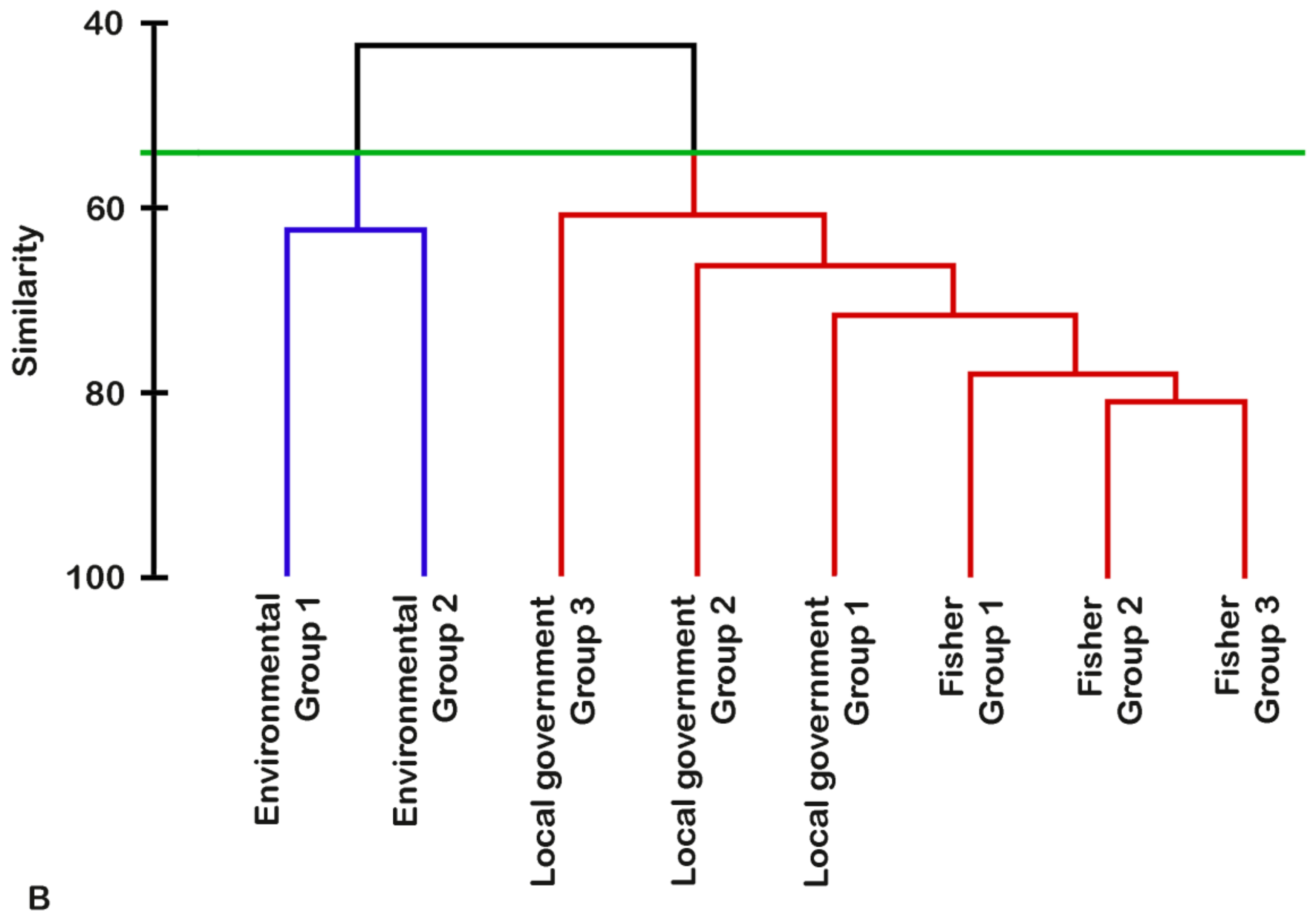
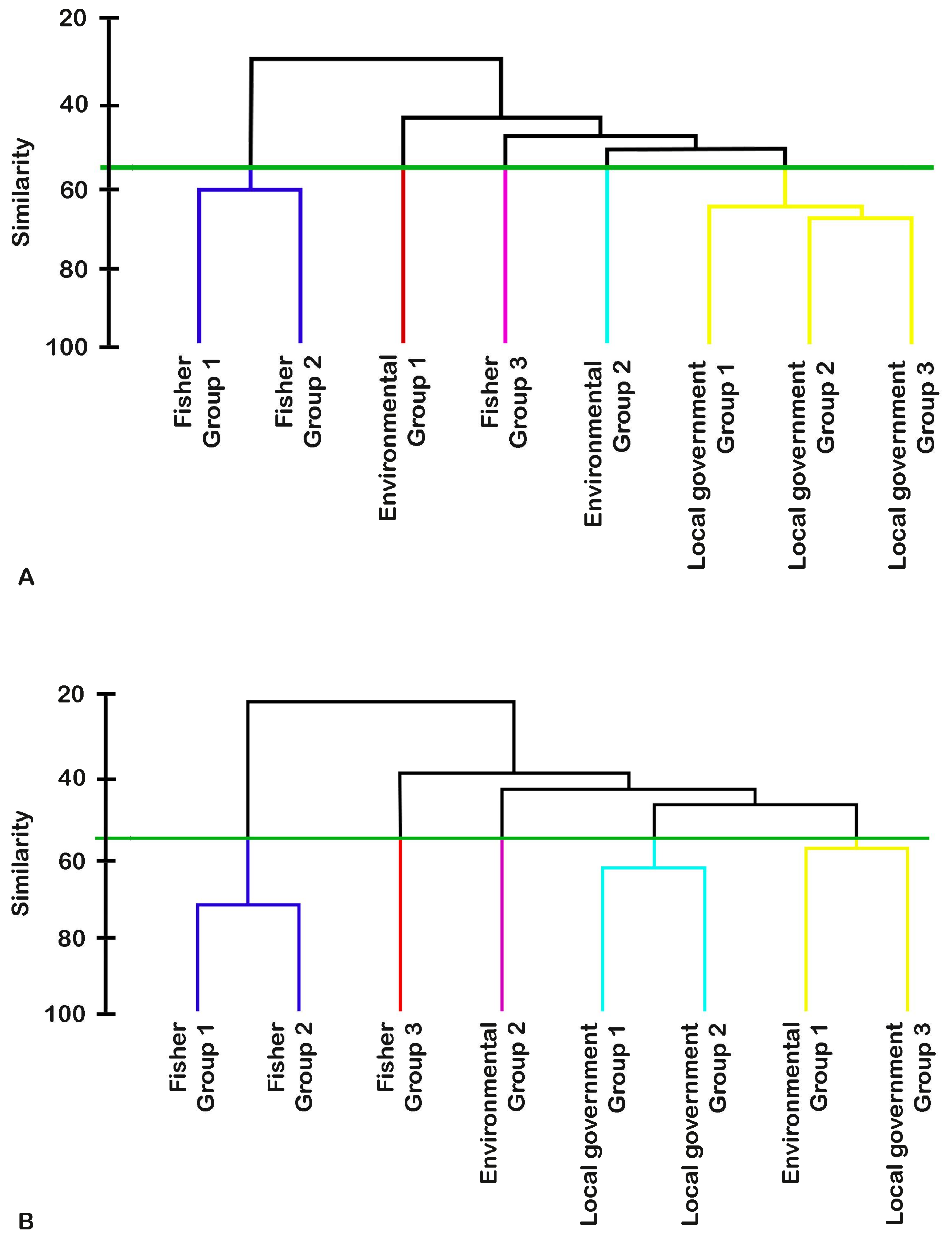
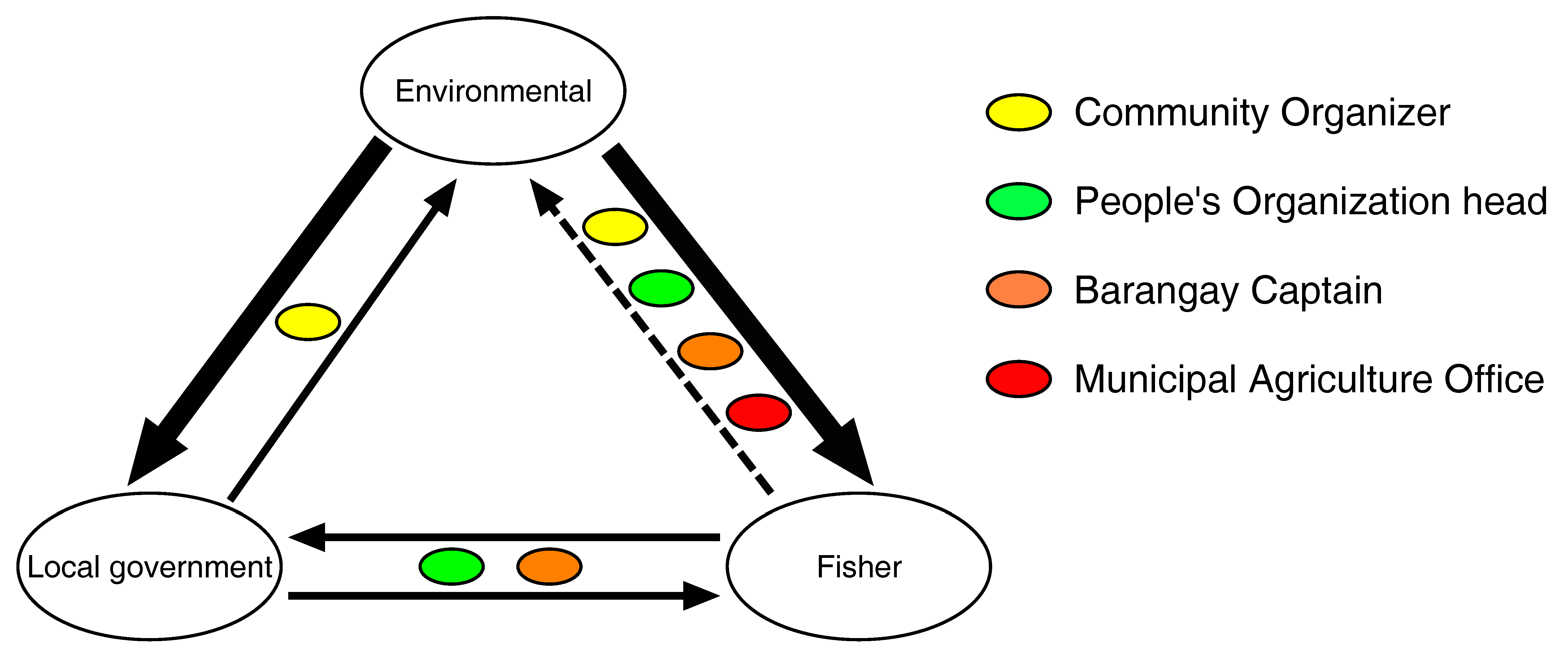
| Perceived Drivers | Stakeholder Types | ||
|---|---|---|---|
| Fisher | Local Government | Environmental | |
| Distal drivers | |||
| Human population increase | |||
| Climate change | |||
| Increase of natural disasters | |||
| Conflicting government policies | |||
| Don’t understand causal effects | |||
| Lack of opportunity | |||
| Inability to implement regulations | |||
| Poverty | |||
| Weak leadership approach | |||
| Proximate drivers | |||
| Dynamite fishing | |||
| Chemical fishing | |||
| Trawl fishing | |||
| Pollution | |||
| Commercial fishing | |||
| Mangrove cutting | |||
| Encroachment | |||
| Non-compliance | |||
| Weak enforcement | |||
| Bad farming practices | |||
| Coral and sand quarrying |
| Perceived Interventions | Stakeholder Types | ||
|---|---|---|---|
| Fisher | Local Government | Environmental | |
| Law enforcement | |||
| Laws and regulations | |||
| Marine reserves | |||
| Information education and communication activities | |||
| Gear swapping | |||
| Coastal clean-up | |||
| Alternative Livelihoods | |||
| Reproductive health laws | |||
| Market denial | |||
| Birth control | |||
| Tree planting | |||
| Recycling programs | |||
| Temporal closures | |||
| Integrated coastal management plans | |||
| Poverty alleviation programs | |||
| Fisher registration | |||
| Fisher/ People Organizations | |||
| Allocation of resources to coastal resource management | |||
| Research | |||
| Stakeholder networking | |||
| Monitor and evaluation | |||
| Coastal resource management plans |
© 2018 by the authors. Licensee MDPI, Basel, Switzerland. This article is an open access article distributed under the terms and conditions of the Creative Commons Attribution (CC BY) license (http://creativecommons.org/licenses/by/4.0/).
Share and Cite
Horowitz, J.; Pressey, R.L.; Gurney, G.G.; Wenger, A.S.; Pahang, K.A. Investigating Stakeholder Perceptions of Fish Decline: Making Sense of Multiple Mental Models. Sustainability 2018, 10, 1222. https://doi.org/10.3390/su10041222
Horowitz J, Pressey RL, Gurney GG, Wenger AS, Pahang KA. Investigating Stakeholder Perceptions of Fish Decline: Making Sense of Multiple Mental Models. Sustainability. 2018; 10(4):1222. https://doi.org/10.3390/su10041222
Chicago/Turabian StyleHorowitz, Jeremy, Robert L. Pressey, Georgina G. Gurney, Amelia S. Wenger, and Kristina A. Pahang. 2018. "Investigating Stakeholder Perceptions of Fish Decline: Making Sense of Multiple Mental Models" Sustainability 10, no. 4: 1222. https://doi.org/10.3390/su10041222





